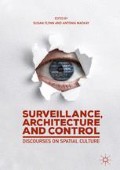Abstract
This chapter addresses military surveillance drones as both a topic and a technological apparatus within videogames. I argue that their representation in the “military strategy” videogame genre makes visible these games’ fundamental mode of spatial processing: the way in which their interfaces construct the game-world from the perspective of a surveillance drone. If we address videogames as architectural problems—material constructions of spatial relations that are enmeshed in wider social and political structures—I argue that we can observe their specific mode of processing space through surveillance technology and the attendant politics of their cultural form. By embedding military surveillance technology in their understanding of space, I argue that these videogames make visible the form of surveillance that Deleuze took to be central to “control”: a free-floating visual perspective that parallels the distributed network form in its occupation of an interconnected system of spaces, rather than the occupation of any one point of observation.
Access this chapter
Tax calculation will be finalised at checkout
Purchases are for personal use only
Bibliography
Aarseth, E. J. (1997). Cybertext: Perspectives on Ergodic Literature. London: The Johns Hopkins University Press.
Agre, P. E. (1994). Surveillance and Capture: Two Models of Privacy. The Information Society, 10(2), 101–127.
Bauman, Z., & Lyon, D. (2013). Liquid Surveillance: A Conversation. Cambridge: Polity.
Caldwell, L., & Lenoir, T. (2016). Wargaming Futures: Naturalizing the New American Way of War. In P. Harrigan & M. G. Kirschenbaum (Eds.), Zones of Control: Perspectives on Wargaming (pp. 253–279). London: MIT Press.
Chamayou, G. (2015). Drone Theory (trans: Lloyd, J.). London: Penguin Books.
Colomina, B. (1994). Privacy and Publicity: Modern Architecture as Mass Media. London: MIT Press.
Deleuze, G. (1995). Negotiations, 1972–1990 (trans: Joughin, M.). New York: Columbia University Press.
Deleuze, G., & Guattari, F. (1987). A Thousand Plateaus: Capitalism and Schizophrenia (trans: Massumi, B.). London: University of Minnesota Press.
Der Derian, J. (2001). Virtuous War: Mapping the Military-Industrial-Media-Entertainment Complex. Boulder: Westview Press.
Foucault, M. (1990). The History of Sexuality, Volume 1: An Introduction (trans: Hurley, R.). New York: Vintage Books.
Foucault, M. (1995). Discipline and Punish: The Birth of the Prison (trans: Sheridan, A.). New York: Vintage Books.
Galloway, A. R. (2007). StarCraft, or, Balance. Grey Room, 28, 86–107.
Galloway, A. R. (2018). Informatic Brutalism. In A. Ring, H. Steiner, & K. Veel (Eds.), Architecture and Control. Leiden: Brill.
Galison, P. (2001). War against the Center. Grey Room, 4, 5–33.
Golumbia, D. (2009). The Cultural Logic of Computation. London: Harvard University Press.
Graham, S. (2007). War and the City. New Left Review, 44, 121–132.
Graham, S. (2009). The Urban “Battlespace”. Theory, Culture & Society., 26(7–8), 278–288.
Graham, S. (2012). When Life Itself Is War: On the Urbanization of Military and Security Doctrine. International Journal of Urban and Regional Research, 36(1), 136–155.
Halpern, O. (2014). Beautiful Data: A History of Vision and Reason since 1945. London: Duke University Press.
Hambling, D. (2008, July 19). Game Controllers Driving Drones, Nukes. Wired. https://www.wired.com/2008/07/wargames/. Accessed 30 Mar 2018.
Kersey, J. (1708). Dictionarium Anglo-Britannicum: Or, A General English Dictionary. London: J. Wilde.
Lenoir, T. (2000). All but War Is Simulation: The Military-Entertainment Complex. Configurations, 8, 289–335.
Lyon, D. (2003). Surveillance as Social Sorting: Computer Codes and Mobile Bodies. In D. Lyon (Ed.), Surveillance as Social Sorting: Privacy, Risk, and Digital Discrimination. London: Routledge.
Manovich, L. (2001). The Language of New Media. London: MIT Press.
Martin, R. (2003). The Organizational Complex: Architecture, Media, and Corporate Space. London: MIT Press.
Martin, R. (2010). Utopia’s Ghost: Architecture and Postmodernism, Again. London: University of Minnesota Press.
Murakami Wood, D. (2009). The “Surveillance Society”: Questions of History, Place and Culture. European Journal of Criminology, 6(2), 179–194.
Norberg-Schulz, C. (1986). Baroque Architecture. London: Faber and Faber.
Overington, C., & Phan, T. (2016). Domesticating Drone Technologies: Commercialisation, Banalisation, and Reconfiguring “Ways of Seeing”. In H. Randell-Moon & R. Tippet (Eds.), Security, Race, Biopower: Essays on Technology and Corporeality. London: Palgrave Macmillan.
Pugliese, J. (2016). Death by Metadata: The Bioinformationalisation of Life and the Transliteration of Algorithms to Flesh. In Randell-Moon & Tippet, Security, Race, Biopower.
Stahl, R. (2010). Militainment, Inc.: War, Media, and Popular Culture. London: Routledge.
Stahl, R. (2013). What the Drone Saw: The Cultural Optics of the Unmanned War. Australian Journal of International Affairs, 67(5), 659–674.
Stiegler, B. (2010). For a New Critique of Political Economy (trans: Ross, D.). Cambridge: Polity.
U.S. Marine Corps. (2007). Marine Rifle Squad. New York: Cosimo Classics.
Wark, M. (2007). Gamer Theory. London: Harvard University Press.
Weizman, E. (2017). Hollow Land: Israel’s Architecture of Occupation (New ed.). London: Verso.
Gameography
Age of Empires. (1997). Ensemble Studios.
Call of Duty 4: Modern Warfare. (2007). Activision.
Sid Meier’s Civilization VI. (2016). Firaxis Games.
Shogun: Total War. (2000). The Creative Assembly.
StarCraft. (1998). Blizzard Entertainment.
StarCraft II: Wings of Liberty. (2010). Blizzard Entertainment.
Tom Clancy’s Rainbow Six: Siege. (2015). Ubisoft Montreal.
Warhammer 40,000. (1987). Games Workshop.
XCOM: Enemy Unknown. (2012). Firaxis Games.
Acknowledgements
I am grateful to Trisha Banerjee and Hunter Dukes for their insightful comments on drafts of this chapter; the research period that formed it was generously supported by Peterhouse, University of Cambridge.
Author information
Authors and Affiliations
Corresponding author
Editor information
Editors and Affiliations
Rights and permissions
Copyright information
© 2019 The Author(s)
About this chapter
Cite this chapter
Zetter, N. (2019). In the Drone-Space: Surveillance, Spatial Processing, and the Videogame as Architectural Problem. In: Flynn, S., Mackay, A. (eds) Surveillance, Architecture and Control. Palgrave Macmillan, Cham. https://doi.org/10.1007/978-3-030-00371-5_12
Download citation
DOI: https://doi.org/10.1007/978-3-030-00371-5_12
Published:
Publisher Name: Palgrave Macmillan, Cham
Print ISBN: 978-3-030-00370-8
Online ISBN: 978-3-030-00371-5
eBook Packages: Literature, Cultural and Media StudiesLiterature, Cultural and Media Studies (R0)

